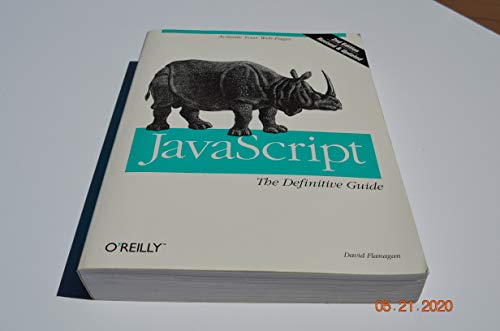
Synopsis
From the bestselling author of Java in a Nutshell comes the definitive reference manual for JavaScript, the HTML extension that allows programs to be embedded in web pages, making them more active than ever before. In this book, David Flanagan describes how JavaScript really works, and when it doesn't. The first eight chapters document the core JavaScript language, and the next six describe how JavaScript works on the client side to interact with the web browser and with the web page. Following this detailed explanation of JavaScript features is a complete reference section that documents every object, property, method, event handler, function, and constructor used by client-side JavaScript. This second edition also describes the server-side JavaScript application, LiveWire, developed by Netscape and Sun Microsystems. Using LiveWire, developers can quickly and easily convert JavaScript applications and any HTML pages containing JavaScript code into platform-independent byte codes ready to run on any Netscape 2.0 Server. The book describes the version of JavaScript shipped with Navigator 2.0, 2.0.1, and 2.0.2, and also the much-changed version of JavaScript shipped with Navigator 3.0. It also covers LiveConnect, used for communication between JavaScript and Java applets, and commonly encountered bugs on JavaScript objects.
"synopsis" may belong to another edition of this title.
Reviews
O'Reilly books have a reputation among programmers for providing some of the best technical information for professionals. No exception, these three web-related books will only enhance O'Reilly's reputation. JavaScript is not Java, but it is very useful because JavaScript code does not need to be compiled and the scripts can be embedded directly into an HTML document. Flanagan's work is an excellent book for programmers interested in learning it quickly. Grand, meanwhile, provides an exceptionally clear discussion of Java itself that is particularly useful for a working programmer moving from C++ to Java. Threads are what makes Java a particularly useful language for multiprocessing?the ability to appear to do more than one thing at a time?which is what the Internet is all about. The tricky part of threads is that the concept is new for most users. Oaks offers a very clear discussion of how to spawn a process, when to spawn, and how to synchronize and schedule it, all illustrated with good network examples.
Copyright 1997 Reed Business Information, Inc.
"About this title" may belong to another edition of this title.
Search results for JavaScript: The Definitive Guide (Nutshell Handbooks)
JavaScript: The Definitive Guide (Nutshell Handbooks)
Seller: World of Books (was SecondSale), Montgomery, IL, U.S.A.
Condition: Very Good. Item in very good condition! Textbooks may not include supplemental items i.e. CDs, access codes etc. Seller Inventory # 00084029572
Javascript : Activate Your Web Pages
Seller: Better World Books, Mishawaka, IN, U.S.A.
Condition: Very Good. 2nd Edition. Used book that is in excellent condition. May show signs of wear or have minor defects. Seller Inventory # 7500928-6
Javascript : Activate Your Web Pages
Seller: Better World Books, Mishawaka, IN, U.S.A.
Condition: Good. 2nd Edition. Used book that is in clean, average condition without any missing pages. Seller Inventory # GRP26715607
JavaScript: The Definitive Guide (Nutshell Handbooks)
Seller: Wonder Book, Frederick, MD, U.S.A.
Condition: Good. Good condition. 2nd edition. A copy that has been read but remains intact. May contain markings such as bookplates, stamps, limited notes and highlighting, or a few light stains. Seller Inventory # Z03A-03896
JavaScript: The Definitive Guide (Nutshell Handbooks)
Seller: ThriftBooks-Reno, Reno, NV, U.S.A.
Paperback. Condition: Very Good. No Jacket. May have limited writing in cover pages. Pages are unmarked. ~ ThriftBooks: Read More, Spend Less. Seller Inventory # G1565922344I4N00
JavaScript: The Definitive Guide (Nutshell Handbooks)
Seller: ThriftBooks-Atlanta, AUSTELL, GA, U.S.A.
Paperback. Condition: Very Good. No Jacket. May have limited writing in cover pages. Pages are unmarked. ~ ThriftBooks: Read More, Spend Less. Seller Inventory # G1565922344I4N00
JavaScript: The Definitive Guide (Nutshell Handbooks)
Seller: ThriftBooks-Phoenix, Phoenix, AZ, U.S.A.
Paperback. Condition: Very Good. No Jacket. May have limited writing in cover pages. Pages are unmarked. ~ ThriftBooks: Read More, Spend Less. Seller Inventory # G1565922344I4N00
JavaScript: The Definitive Guide (Nutshell Handbooks)
Seller: ThriftBooks-Dallas, Dallas, TX, U.S.A.
Paperback. Condition: Very Good. No Jacket. May have limited writing in cover pages. Pages are unmarked. ~ ThriftBooks: Read More, Spend Less. Seller Inventory # G1565922344I4N00
JavaScript: The Definitive Guide (Nutshell Handbooks)
Seller: HPB-Emerald, Dallas, TX, U.S.A.
paperback. Condition: Very Good. Connecting readers with great books since 1972! Used books may not include companion materials, and may have some shelf wear or limited writing. We ship orders daily and Customer Service is our top priority! Seller Inventory # S_444949949
JavaScript: The Definitive Guide (A Nutshell handbook)
Seller: WorldofBooks, Goring-By-Sea, WS, United Kingdom
Paperback. Condition: Very Good. The book has been read, but is in excellent condition. Pages are intact and not marred by notes or highlighting. The spine remains undamaged. Seller Inventory # GOR001489318
Buy Used
Ships from United Kingdom to U.S.A.
Quantity: 2 available
